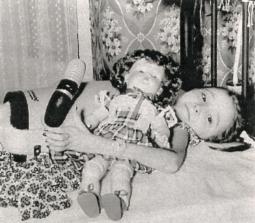Polio Place
A service of Post-Polio Health International
Artifacts
Away from Home
Carol Purington; Massachusetts
I began first grade in September, and I recall getting on the bus with my sisters, Marion and Jean. As for my one day at school, all I remember is resting my head on the desk because I had a headache. That night I still wasn’t feeling well, and my mother gave me a warm bath. In that season of water shortages it was unusual for one of us children to have a bath alone.
My next memory involves having something painful done to my back at the local hospital – a spinal tap. It tested positive for the polio virus. I didn’t know until later that Marion and Jim, my brother, also had spinal taps that were positive, but they had no symptoms. Jean had been a Polio Pioneer, meaning that she had been among those school children on whom the Salk vaccine was tested. For some reason now forgotten, the younger children did not have spinal taps.
Then I remember being in a strange room, a hospital room. My parents were saying goodbye. I understood that they must return to the family farm so that my mother could care for the other children and my father could tend the cows.
I had slept away from home before, but only in the company of close relatives – several times at my Grandmother Hillman’s apartment and once at the house of Aunt Alice and Aunt Gertrude. (They were great-aunts who lived in Ithaca, New York, and I had visited them with my father.) At home I had shared a room with my two older sisters since moving out of the crib in my parents’ bedroom. Until that first night in the hospital, I don’t think I had ever slept in a room by myself.
I remember a nurse coming into the brightly lit room, wheeling a cart that held hot packs. These strips of cloth were placed on the arms and legs of persons with polio, especially during the acute phase of the infection. The steamy smell of wet fabric can still bring back the feel of those days. But oddly, I don’t remember pain, either from the application of the extremely hot packs or from the devastation the polio virus was causing to my body.
The next memory is of someone instructing me how to synchronize drinking through a straw and swallowing the liquid with the breathing of the iron lung that enclosed me, all except my head. This period is associated in my mind with having lots of shots and with being cared for through the iron lung’s portholes (little, round doors in its sides). Unlike some polio patients, I don’t remember ever being afraid of the lung or feeling claustrophobic about being inside it. Neither do I recall asking for or receiving any information about this big yellow machine or why I was in it.
These memories are disconnected, like still photographs that are arranged in definite order but not adequately labeled. In all of them I am aware that I am lying down, but there is little background, little emotion, few people, no talking. I certainly didn’t realize that during this blur of days I had a very high fever and was critically ill.


















































